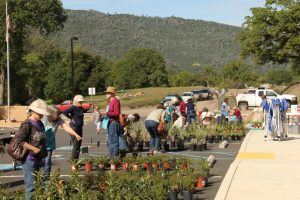Drought-Tolerant Wildflowers
Here we are in the middle of another California drought. It’s been a long, hot, summer and many of us are already daydreaming of fall, winter and spring. So, now is a good time to start evaluating the addition of native wildflowers to your landscape. They are low maintenance, drought-tolerant, and provide colorful beauty that blends in with the natural landscape in the Sierra Foothills. In addition, they provide biological diversity to our native ecosystems, which attracts birds and butterflies.
Some varieties may be purchased from your local garden center by individual species. Commercially available wildflower seed mixes are available, but some are not native to the area, so it is wise to do your research in order to prevent the invitation of invasive non-natives.
Prepare the planting site by weeding, then rake or rototill the soil to a depth of an inch or two. Spread the seeds over the prepared soil and cover lightly with soil or compost, which allows smaller seeds to germinate. Gently pat down the soil.
It is crucial to plant wildflowers in the same conditions in which they grow naturally. Keep the soil-covered seeds moist for four to six weeks to allow for germination. Plant in fall in anticipation of precipitation to help the process along. Come spring, the wildflowers will begin to bloom, along with other spring flowers in your landscape. Some supplemental watering may be needed if rainfall is limited due to ongoing drought conditions. But, once established, minimal additional water is needed.
A few of the native wildflowers of the Sierra Foothills include:
- California poppy, Eschscholzia californica
- miniature lupine, Lupinus bicolor
- blue dicks, Dichelostemma capitatum
- farewell to spring, Clarkia amoena
- five spot, Nemophila maculata
- baby blue eyes, Nemophila menziesii
- Chinese houses, Collinsia heterophylla
- Western columbine, Aquilegia formosa
- coral bells, Heuchera
- snowplant, Sarcodes sanguinea
The California Native Plant Society (CNPS.org) and The Stanislaus National Forest (fs.usda.gov) and Yosemite National Forest (nps.gov/yose) have great information regarding native wildflowers and when and where to view them in our area.
The next time you take a drive, stroll, or hike, stop and take a picture of a wildflower you might like to plant. You can identify it for future planting by uploading the photo to one of the plant identification applications, such as iNaturalist or Seek. In that way, you can determine the plant name and whether the seed is available commercially. You can also type your location into the app, add the name, or part of the name, of a particular plant of interest and research its commercial availability.
Please keep in mind, there are consequences to poaching native wildflowers and their seed. They don’t usually survive transplantation, and may upset the ecosystem by removing them. The good news is we are surrounded by native wildflowers and their beauty, and can just enjoy them in their natural setting. It doesn’t get any better than that!
Ann Arshakuni is a University of California Cooperative Extension Master Gardener of Calaveras County.
UCCE Master Gardeners of Tuolumne and Calaveras Counties can answer home gardening questions. Call 209-533-5912 or fill out our easy-to-use problem questionnaire here. Check out our website here. You can also find us on Facebook.

